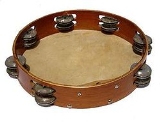
Tambourine
Encyclopedia
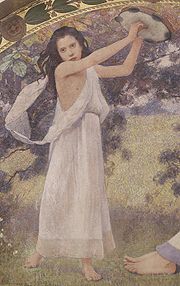
Musical instrument
A musical instrument is a device created or adapted for the purpose of making musical sounds. In principle, any object that produces sound can serve as a musical instrument—it is through purpose that the object becomes a musical instrument. The history of musical instruments dates back to the...
of the percussion
Percussion instrument
A percussion instrument is any object which produces a sound when hit with an implement or when it is shaken, rubbed, scraped, or otherwise acted upon in a way that sets the object into vibration...
family
Family
In human context, a family is a group of people affiliated by consanguinity, affinity, or co-residence. In most societies it is the principal institution for the socialization of children...
consisting of a frame, often of wood
Wood
Wood is a hard, fibrous tissue found in many trees. It has been used for hundreds of thousands of years for both fuel and as a construction material. It is an organic material, a natural composite of cellulose fibers embedded in a matrix of lignin which resists compression...
or plastic
Plastic
A plastic material is any of a wide range of synthetic or semi-synthetic organic solids used in the manufacture of industrial products. Plastics are typically polymers of high molecular mass, and may contain other substances to improve performance and/or reduce production costs...
, with pairs of small metal
Metal
A metal , is an element, compound, or alloy that is a good conductor of both electricity and heat. Metals are usually malleable and shiny, that is they reflect most of incident light...
jingles
Jingle (music)
A jingle is a small metal disc, such as those arranged around the frame of a tambourine.That term is referenced in Bob Dylan's hit song, Mr. Tambourine Man. It is an onomatopoeic term, often used together with jangle...
, called "zils". Classically the term tambourine denotes an instrument with a drumhead, though some variants may not have a head at all. Tambourines are often used with regular percussion sets. They can be mounted, but position is largely down to preference.
Tambourines come in many different shapes with the most common being circular
Circle
A circle is a simple shape of Euclidean geometry consisting of those points in a plane that are a given distance from a given point, the centre. The distance between any of the points and the centre is called the radius....
. It is found in many forms of music: Greek folk music
Greek folk music
Greek folk music includes a variety of Greek styles played by ethnic Greeks in Greece, Cyprus, Australia, the United States and elsewhere. Apart from the common music found all-around Greece, there are distinct types of folk music, sometimes related to the history or simply the taste of the...
, Italian folk music
Italian folk music
Italian folk music has a deep and complex history. National unification came quite late to the Italian peninsula, so its many hundreds of separate cultures remained un-homogenized until quite recently compared to many other European countries...
, classical music
Classical music
Classical music is the art music produced in, or rooted in, the traditions of Western liturgical and secular music, encompassing a broad period from roughly the 11th century to present times...
, Persian music, gospel music
Gospel music
Gospel music is music that is written to express either personal, spiritual or a communal belief regarding Christian life, as well as to give a Christian alternative to mainstream secular music....
, pop music
Pop music
Pop music is usually understood to be commercially recorded music, often oriented toward a youth market, usually consisting of relatively short, simple songs utilizing technological innovations to produce new variations on existing themes.- Definitions :David Hatch and Stephen Millward define pop...
and rock music
Rock music
Rock music is a genre of popular music that developed during and after the 1960s, particularly in the United Kingdom and the United States. It has its roots in 1940s and 1950s rock and roll, itself heavily influenced by rhythm and blues and country music...
.
The word tambourine finds its origins in French tambourin, which referred to a long narrow drum used in Provence, the word being a diminutive of tambour "drum," altered by influence of Arabic tunbur "drum". from the Middle Persian
Middle Persian
Middle Persian , indigenously known as "Pârsig" sometimes referred to as Pahlavi or Pehlevi, is the Middle Iranian language/ethnolect of Southwestern Iran that during Sassanid times became a prestige dialect and so came to be spoken in other regions as well. Middle Persian is classified as a...
word tambūr "lute, drum".
According to Phil Collins
Phil Collins
Philip David Charles "Phil" Collins, LVO is an English singer-songwriter, drummer, pianist and actor best known as a drummer and vocalist for British progressive rock group Genesis and as a solo artist....
it is the most important instrument in Motown.
Playing
The tambourine can be held in the hand or mounted on a stand, and can be played in numerous ways, from stroking or shaking the jinglesJingle (music)
A jingle is a small metal disc, such as those arranged around the frame of a tambourine.That term is referenced in Bob Dylan's hit song, Mr. Tambourine Man. It is an onomatopoeic term, often used together with jangle...
to striking it sharply with hand or stick or using the tambourine to strike the leg or hip.
Tambourine rolls
There are several ways to achieve a tambourine roll. The easiest method is to rapidly rotate the hand holding the tambourine back and forth, pivoting at the wrist.Thumb roll
An advanced playing technique is known as the thumb roll. The finger or thumb is moved over the skin or rim of the tambourine, producing a fast roll from the jingles on the instrument. This takes more skill and experience to master.The thumb of the hand not holding the tambourine is run around the head of the instrument approximately one centimeter from the rim with some pressure applied. If performed correctly, the thumb should bounce along the head rapidly, producing the roll.
The thumb roll technique can be made easier with the application of wax or resin to the head. A continuous roll can be achieved by moving the thumb in a figure of 8 pattern around the head.
Pandeiro
Originated in PortugalPortugal
Portugal , officially the Portuguese Republic is a country situated in southwestern Europe on the Iberian Peninsula. Portugal is the westernmost country of Europe, and is bordered by the Atlantic Ocean to the West and South and by Spain to the North and East. The Atlantic archipelagos of the...
, the pandeiro was brought to Brazil
Brazil
Brazil , officially the Federative Republic of Brazil , is the largest country in South America. It is the world's fifth largest country, both by geographical area and by population with over 192 million people...
by the Portuguese
Portuguese people
The Portuguese are a nation and ethnic group native to the country of Portugal, in the west of the Iberian peninsula of south-west Europe. Their language is Portuguese, and Roman Catholicism is the predominant religion....
settlers. It is a hand percussion instrument consisting of a single tension-headed drum with jingles in the frame. It is very typical of more traditional brazilian music
Panderoa
The BasqueBasque music
The strict classification of Basque music remains a controversial issue, complicated in part by the growing diversification of such music, but by and large it is made in the Basque Country, it reflects traits related to that society/tradition and it is devised by people from the Basque...
pandero is a folk instrument currently played along with the diatonic accordion
Trikitixa
The trikiti , trikitixa or eskusoinu txiki is a two-row Basque diatonic button accordion with right-hand rows keyed a fifth apart and twelve unisonoric bass buttons...
in a duo most of the times. Sometimes the players, who play in festivities to enliven the atmosphere or less frequently at onstage performances, sing along. At times the pandero accompanies the alboka
Alboka
The alboka is a double hornpipe or clarinet native to the Basque Country.Although the alboka is a woodwind instrument, its name is derived from the Arabic "al-bûq"...
or txistu
Txistu
The txistu or chistu is a kind of fipple flute that became a symbol for the Basque folk revival. The name may stem from the general Basque word ziztu "to whistle" with palatalisation of the z...
too. Yet this kind of duos have not always been the case. As attested in 1923, the youth gathered to dance to the rhythm of the bare pandero, with no other music instrument implicated but the player's (a woman's) voice.
Riq
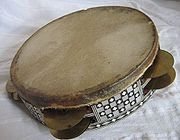
Riq
The riq is a type of tambourine used as a traditional instrument in Arabic music. It is an important instrument in both folk and classical music throughout the Arabic-speaking world...
(also spelled riqq or rik) is a type of tambourine used as a traditional instrument in Arabic music
Arab music
Arabic music or Arab music is the music of the Arab World, including several genres and styles of music ranging from Arabic classical to Arabic pop music and from secular to sacred music....
. It is an important instrument in both folk and classical music throughout the Arabic-speaking world.
Widely known as "Shakers".
Buben
Buben (Бубен in RussianRussian language
Russian is a Slavic language used primarily in Russia, Belarus, Uzbekistan, Kazakhstan, Tajikistan and Kyrgyzstan. It is an unofficial but widely spoken language in Ukraine, Moldova, Latvia, Turkmenistan and Estonia and, to a lesser extent, the other countries that were once constituent republics...
, Бубон in Ukrainian
Ukrainian language
Ukrainian is a language of the East Slavic subgroup of the Slavic languages. It is the official state language of Ukraine. Written Ukrainian uses a variant of the Cyrillic alphabet....
, boben in Slovenian
Slovenian language
Slovene or Slovenian is a South Slavic language spoken by approximately 2.5 million speakers worldwide, the majority of whom live in Slovenia. It is the first language of about 1.85 million people and is one of the 23 official and working languages of the European Union...
, buben in Czech
Czech language
Czech is a West Slavic language with about 12 million native speakers; it is the majority language in the Czech Republic and spoken by Czechs worldwide. The language was known as Bohemian in English until the late 19th century...
, bęben in Polish
Polish language
Polish is a language of the Lechitic subgroup of West Slavic languages, used throughout Poland and by Polish minorities in other countries...
) is a musical instrument
Musical instrument
A musical instrument is a device created or adapted for the purpose of making musical sounds. In principle, any object that produces sound can serve as a musical instrument—it is through purpose that the object becomes a musical instrument. The history of musical instruments dates back to the...
of the percussion family
Percussion instrument
A percussion instrument is any object which produces a sound when hit with an implement or when it is shaken, rubbed, scraped, or otherwise acted upon in a way that sets the object into vibration...
similar to a tambourine. A buben consists of a wooden or metal hoop with a tight membrane stretched over one of its sides (some bubens have no membrane at all). Certain kinds of bubens are equipped with clanking metal rings, plates, cymbal
Cymbal
Cymbals are a common percussion instrument. Cymbals consist of thin, normally round plates of various alloys; see cymbal making for a discussion of their manufacture. The greater majority of cymbals are of indefinite pitch, although small disc-shaped cymbals based on ancient designs sound a...
s, or little bells. It is held in the hand and can be played in numerous ways, from stroking or shaking the jingles to striking it sharply with hand. It is used for rhythmical accompaniment
Accompaniment
In music, accompaniment is the art of playing along with an instrumental or vocal soloist or ensemble, often known as the lead, in a supporting manner...
during dances, soloist or choral singing. Buben is often used by some folk and professional bands, as well as orchestras.
The name is related to Greek language
Greek language
Greek is an independent branch of the Indo-European family of languages. Native to the southern Balkans, it has the longest documented history of any Indo-European language, spanning 34 centuries of written records. Its writing system has been the Greek alphabet for the majority of its history;...
βόμβος (low and hollow sound) and βομβύλη (a breed of bees) and related to Indo-Aryan
Indo-Aryan languages
The Indo-Aryan languages constitutes a branch of the Indo-Iranian languages, itself a branch of the Indo-European language family...
bambharas (bee) and English
English language
English is a West Germanic language that arose in the Anglo-Saxon kingdoms of England and spread into what was to become south-east Scotland under the influence of the Anglian medieval kingdom of Northumbria...
bee.
Buben is known to have existed in many countries since time immemorial, especially in the East
East
East is a noun, adjective, or adverb indicating direction or geography.East is one of the four cardinal directions or compass points. It is the opposite of west and is perpendicular to north and south.By convention, the right side of a map is east....
. There are many kinds of bubens, including def, daf
Daf
A daf is a frame drum used as a musical instrument in popular and classical music. The term daf is used in Iran / Kurdistan for a large drum that has a series of four interlinked rings in the frame. Daf is mostly used in Middle East, Iran, Armenia, Pakistan, Turkey, Tajikistan, Azerbaijan and ...
, or qaval (Azerbaijan
Azerbaijan
Azerbaijan , officially the Republic of Azerbaijan is the largest country in the Caucasus region of Eurasia. Located at the crossroads of Western Asia and Eastern Europe, it is bounded by the Caspian Sea to the east, Russia to the north, Georgia to the northwest, Armenia to the west, and Iran to...
), daf or khaval (Armenia
Armenia
Armenia , officially the Republic of Armenia , is a landlocked mountainous country in the Caucasus region of Eurasia...
), daira (Georgia
Georgia (country)
Georgia is a sovereign state in the Caucasus region of Eurasia. Located at the crossroads of Western Asia and Eastern Europe, it is bounded to the west by the Black Sea, to the north by Russia, to the southwest by Turkey, to the south by Armenia, and to the southeast by Azerbaijan. The capital of...
), doira (Uzbekistan
Uzbekistan
Uzbekistan , officially the Republic of Uzbekistan is a doubly landlocked country in Central Asia and one of the six independent Turkic states. It shares borders with Kazakhstan to the west and to the north, Kyrgyzstan and Tajikistan to the east, and Afghanistan and Turkmenistan to the south....
and Tajikistan
Tajikistan
Tajikistan , officially the Republic of Tajikistan , is a mountainous landlocked country in Central Asia. Afghanistan borders it to the south, Uzbekistan to the west, Kyrgyzstan to the north, and China to the east....
), daire or def (Iran
Iran
Iran , officially the Islamic Republic of Iran , is a country in Southern and Western Asia. The name "Iran" has been in use natively since the Sassanian era and came into use internationally in 1935, before which the country was known to the Western world as Persia...
), bendeir (Arab
Arab
Arab people, also known as Arabs , are a panethnicity primarily living in the Arab world, which is located in Western Asia and North Africa. They are identified as such on one or more of genealogical, linguistic, or cultural grounds, with tribal affiliations, and intra-tribal relationships playing...
countries), pandero (Spain
Spain
Spain , officially the Kingdom of Spain languages]] under the European Charter for Regional or Minority Languages. In each of these, Spain's official name is as follows:;;;;;;), is a country and member state of the European Union located in southwestern Europe on the Iberian Peninsula...
). In Kievan Rus, drum
Drum
The drum is a member of the percussion group of musical instruments, which is technically classified as the membranophones. Drums consist of at least one membrane, called a drumhead or drum skin, that is stretched over a shell and struck, either directly with the player's hands, or with a...
s and military timpani
Timpani
Timpani, or kettledrums, are musical instruments in the percussion family. A type of drum, they consist of a skin called a head stretched over a large bowl traditionally made of copper. They are played by striking the head with a specialized drum stick called a timpani stick or timpani mallet...
were referred to as buben.
Dayereh

Frame drum
A frame drum is a drum that has a drumhead width greater than its depth. Usually the single drumhead is made of rawhide or man-made materials. Shells are traditionally constructed of bent wood scarf jointed together; plywood and man-made materials are also used. Some frame drums have mechanical...
with jingles
Jingle (music)
A jingle is a small metal disc, such as those arranged around the frame of a tambourine.That term is referenced in Bob Dylan's hit song, Mr. Tambourine Man. It is an onomatopoeic term, often used together with jangle...
used to accompany both popular and classical music in Iran
Iran
Iran , officially the Islamic Republic of Iran , is a country in Southern and Western Asia. The name "Iran" has been in use natively since the Sassanian era and came into use internationally in 1935, before which the country was known to the Western world as Persia...
(Persia), the Balkans
Balkans
The Balkans is a geopolitical and cultural region of southeastern Europe...
, and many central Asian countries such as Tajikistan
Tajikistan
Tajikistan , officially the Republic of Tajikistan , is a mountainous landlocked country in Central Asia. Afghanistan borders it to the south, Uzbekistan to the west, Kyrgyzstan to the north, and China to the east....
and Uzbekistan
Uzbekistan
Uzbekistan , officially the Republic of Uzbekistan is a doubly landlocked country in Central Asia and one of the six independent Turkic states. It shares borders with Kazakhstan to the west and to the north, Kyrgyzstan and Tajikistan to the east, and Afghanistan and Turkmenistan to the south....
. It is a percussion instrument
Percussion instrument
A percussion instrument is any object which produces a sound when hit with an implement or when it is shaken, rubbed, scraped, or otherwise acted upon in a way that sets the object into vibration...
, and is something intermediate between a drum
Drum
The drum is a member of the percussion group of musical instruments, which is technically classified as the membranophones. Drums consist of at least one membrane, called a drumhead or drum skin, that is stretched over a shell and struck, either directly with the player's hands, or with a...
and a tambourine.
Daf

Iran
Iran , officially the Islamic Republic of Iran , is a country in Southern and Western Asia. The name "Iran" has been in use natively since the Sassanian era and came into use internationally in 1935, before which the country was known to the Western world as Persia...
, Azerbaijan
Azerbaijan
Azerbaijan , officially the Republic of Azerbaijan is the largest country in the Caucasus region of Eurasia. Located at the crossroads of Western Asia and Eastern Europe, it is bounded by the Caspian Sea to the east, Russia to the north, Georgia to the northwest, Armenia to the west, and Iran to...
, Turkey
Turkey
Turkey , known officially as the Republic of Turkey , is a Eurasian country located in Western Asia and in East Thrace in Southeastern Europe...
(where it is called tef), Uzbekistan
Uzbekistan
Uzbekistan , officially the Republic of Uzbekistan is a doubly landlocked country in Central Asia and one of the six independent Turkic states. It shares borders with Kazakhstan to the west and to the north, Kyrgyzstan and Tajikistan to the east, and Afghanistan and Turkmenistan to the south....
(where it's called childirma), India
India
India , officially the Republic of India , is a country in South Asia. It is the seventh-largest country by geographical area, the second-most populous country with over 1.2 billion people, and the most populous democracy in the world...
(where it is known as the Dafli) Turkmenistan
Turkmenistan
Turkmenistan , formerly also known as Turkmenia is one of the Turkic states in Central Asia. Until 1991, it was a constituent republic of the Soviet Union, the Turkmen Soviet Socialist Republic . Turkmenistan is one of the six independent Turkic states...
, and Iranian Kurdistan
Iranian Kurdistan
Iranian Kurdistan is an unofficial name for the parts of Iran inhabited by Kurds and has borders with Iraq and Turkey. It includes Kurdistan Province, Kermanshah Province, Ilam Province and parts of West Azerbaijan province....
. Daf typically indicates the beat and tempo of the music being played, thus acts like the conductor in the monophonic oriental music. The Persian poet Rudaki
Rudaki
Abu Abdollah Jafar ibn Mohammad Rudaki , also written as Rudagi , was a Persian poet, and is regarded as the first great literary genius of the Modern Persian, who composed poems in the "New Persian" alphabet. Rudaki is considered as a founder of Persian classical literature.He was born in 858 in...
, who widely used names of the musical instruments in his poems, mentions the daf and the tambourine (taboorak) in a Ruba'i:
Kanjira
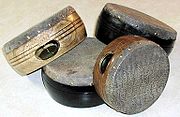
Kanjira
The kanjira, khanjira or ganjira, a South Indian frame drum, is an instrument of the tambourine family. It is used primarily in concerts of Carnatic music as a supporting instrument for the mridangam...
or ganjira is a South India
South India
South India is the area encompassing India's states of Andhra Pradesh, Karnataka, Kerala and Tamil Nadu as well as the union territories of Lakshadweep and Pondicherry, occupying 19.31% of India's area...
n frame drum of the tambourine family. It is mostly used in Carnatic music
Carnatic music
Carnatic music is a system of music commonly associated with the southern part of the Indian subcontinent, with its area roughly confined to four modern states of India: Andhra Pradesh, Karnataka, Kerala, and Tamil Nadu...
concerts (South Indian classical music) as a supporting instrument for the mridangam.
Timbrel
Timbrel or tabret (the tof of the ancient HebrewsHebrews
Hebrews is an ethnonym used in the Hebrew Bible...
, the deff of Islam
Islam
Islam . The most common are and . : Arabic pronunciation varies regionally. The first vowel ranges from ~~. The second vowel ranges from ~~~...
, the adufe of the Moors of Spain
Spain
Spain , officially the Kingdom of Spain languages]] under the European Charter for Regional or Minority Languages. In each of these, Spain's official name is as follows:;;;;;;), is a country and member state of the European Union located in southwestern Europe on the Iberian Peninsula...
), the principal musical instrument of percussion of the Israelites, similar to the modern tambourine.
Rebana
Rebana is a Malay tambourine that is used in Islamic devotional music in Southeast Asia, particularly in IndonesiaIndonesia
Indonesia , officially the Republic of Indonesia , is a country in Southeast Asia and Oceania. Indonesia is an archipelago comprising approximately 13,000 islands. It has 33 provinces with over 238 million people, and is the world's fourth most populous country. Indonesia is a republic, with an...
, Malaysia, Brunei
Brunei
Brunei , officially the State of Brunei Darussalam or the Nation of Brunei, the Abode of Peace , is a sovereign state located on the north coast of the island of Borneo, in Southeast Asia...
, and Singapore
Singapore
Singapore , officially the Republic of Singapore, is a Southeast Asian city-state off the southern tip of the Malay Peninsula, north of the equator. An island country made up of 63 islands, it is separated from Malaysia by the Straits of Johor to its north and from Indonesia's Riau Islands by the...
.
See also
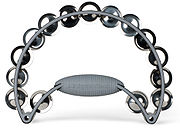
- Frame drumFrame drumA frame drum is a drum that has a drumhead width greater than its depth. Usually the single drumhead is made of rawhide or man-made materials. Shells are traditionally constructed of bent wood scarf jointed together; plywood and man-made materials are also used. Some frame drums have mechanical...
- DayerehDayerehA dayereh is a medium-sized frame drum with jingles, used to accompany both popular and classical music in Iran , the Balkans, and many Central Asian countries such as Tajikistan, Uzbekistan and Afghanistan...
- BendirBendirThe bendir is a frame drum used as a traditional instrument throughout North Africa. Unlike the tambourine, it has no jingles but most often has a snare stretched across its head, which when the drum is struck with the fingers or palm gives the tone a buzzing quality.The bendir is a frame drum...
- DafDafA daf is a frame drum used as a musical instrument in popular and classical music. The term daf is used in Iran / Kurdistan for a large drum that has a series of four interlinked rings in the frame. Daf is mostly used in Middle East, Iran, Armenia, Pakistan, Turkey, Tajikistan, Azerbaijan and ...
- RiqRiqThe riq is a type of tambourine used as a traditional instrument in Arabic music. It is an important instrument in both folk and classical music throughout the Arabic-speaking world...
- TimbrelTimbrelTimbrel or tabret , the principal musical instrument of percussion of the Israelites, similar to the modern tambourine.-History:...
- TamborimTamborimA tamborim is a small, round Brazilian frame drum of Portuguese and African origin.The frame is 6" in width and may be made of metal, plastic, or wood. The head is typically made of nylon and is normally very tightly tuned in order to ensure a high, sharp timbre and a minimum of sustain...
- RavanneRavanneThe ravanne is a large tambourine-like instrument used in sega music of Mauritius. It is made out of goat skinand before playing, it needs to be heated up. The instrument itself is of african origin. No-one knows exactly but it is likely to be from swahili people of kenya or from the west of africa...
- BodhránBodhránThe bodhrán is an Irish frame drum ranging from 25 to 65 cm in diameter, with most drums measuring 35 to 45 cm . The sides of the drum are 9 to 20 cm deep. A goatskin head is tacked to one side...

